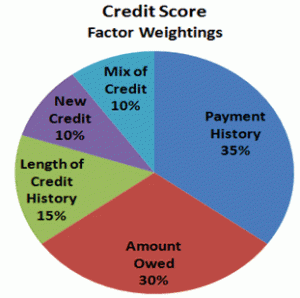What’s In Your Credit Score
Jun 22, 2016 • Written by Paul Staib | Certified Financial Planner (CFP®), MBA, RICP®
Blog Home » Financial Planning » What’s In Your Credit Score

Credit scoring has been in existence since the late 1950s, when it was first used by large retail stores and in finance companies to support lending decisions.
Scoring has evolved over the years and today is utilized by a broad range of potential creditors, as well as insurance companies, mortgage lenders, and even employers.
While there are several different versions of the credit score, the FICO score – introduced in 1989 by the Fair Isaac Corporation – has become the most commonly used measurement to evaluate an individual’s ability to repay debts and determine how favorable payment terms will be. The chart to the right summarizes the five categories – and corresponding percentages of importance – that are considered when calculating a FICO score, which ranges between 300 – 850. To purchase your FICO score, visit www.myFICO.com.
Credit Score Factors
Because some parts of your bill-paying history are more important than others, different pieces of your credit history are given different weights in calculating your credit score. Even though the specific equation for coming up with your credit score is proprietary information owned by Fair Isaac, we do know what information is used to calculate your score.
- Payment History (35%) – Lenders are most concerned about whether or not you pay your bills. The best indicator of this is how you’ve paid your bills in the past. Late payments, collections, and bankruptcies all affect the payment history of your credit score. More recent delinquencies hurt your credit score more than those in the past.
- Amount Owed (30%) – The amount of debt you have in comparison to your credit limits is known as credit utilization. The higher your credit utilization – the closer you are to your limits – the lower your credit score will be. Keep your credit card balances at about 30% of your credit limit or less.
- Length of Credit History (15%) – Having a longer credit history is favorable because it gives more information about your spending habits. It’s good to leave open the accounts that you’ve had for a long time.
- New Credit Inquiries (10%) – Each time you make an application for credit, an inquiry is added to your credit report. Too many applications for credit can mean that you are taking on a lot of debt or that you are in some kind of financial trouble. While inquiries can remain on your credit report for two years, your credit score calculation only considers those made within a year
- Mix of Credit (10%) – Having different kinds of accounts is favorable because it shows that you have experience managing a mix of credit. This isn’t a significant factor in your credit score unless you don’t have much other information on which to base your score. Open new accounts as you need them, not to simply have what seems like a better mix of credit.
Why Your FICO Credit Score is Important
We’ve determined what makes up a credit score, but why is it so important? Your credit score will follow you for your entire life and if you are ever trying to borrow money, the lender is going to look at your credit score to determine whether or not to lend money to you. Need to buy a car? They will check your credit score. Looking for a mortgage? You can bet they are checking your credit score. In fact, even some employers are checking credit scores when hiring to possibly determine who would make a good employee.
Not only does your credit score determine whether or not you’ll receive financing, it also determines how much it will cost you to borrow that money. People with higher credit scores are deemed to be less of a risk and therefore will typically receive the lowest interest rates. Those with lower scores are viewed as more of a risk so the bank will offset that risk by lending you money at a higher interest rate. And when you’re talking about larger loans such as buying a vehicle or a home, just an extra interest rate point could add up to thousands, and even tens of thousands of dollars wasted on interest.
Tips for Improving Your Credit Score
A higher credit score can result in better financial options for you, including more attractive interest rates and loan terms, potentially saving you money over the long term. As detailed above, the bulk of your credit score comes from your payment history and how much debt you actually have. Those two items account for 65% of your score. So, if you’re really looking to improve your credit score, these are the areas you’ll want to tackle first. While there are no quick fixes for increasing your score, here are some tips for raising it over time:
Make timely payments – your payment history has greater influence on your credit score than any other factor. Paying at least a minimum amount on every debt – on or before the due date each month – will help boost your score. Remember that paying your bills late or having an account referred to collections can negatively affect your score.
Pay down debt – consider paying down your revolving credit rather than moving it around. (Note that reducing the number of open revolving accounts but maintaining the same outstanding balance may actually decrease your score.) So try to keep credit card and other revolving account balances low.
Manage new account openings – the third-highest factor in determining your credit score is the length of your credit history. Opening new accounts will lower your average account age, which may reduce your score – especially if you don’t have a lot of other credit information. If you’ve been managing your credit for a short period of time, be mindful of opening new accounts to rapidly.

Paul Staib | Certified Financial Planner (CFP®), MBA, RICP®
Paul Staib, Certified Financial Planner (CFP®), RICP®, is an independent Flat Fee-Only financial planner. Staib Financial Planning, LLC provides comprehensive financial planning, retirement planning, and investment management services to help clients in all financial situations achieve their personal financial goals. Staib Financial Planning, LLC serves clients as a fiduciary and never earns a commission of any kind. Our offices are located in the south Denver metro area, enabling us to conveniently serve clients in Highlands Ranch, Littleton, Lone Tree, Aurora, Parker, Denver Tech Center, Centennial, Castle Pines and surrounding communities. We also offer our services virtually.
Read Next
3 Portfolio Checkup Traps to Avoid
• Written By Paul Staib | Certified Financial Planner (CFP®), MBA, RICP®
Here are a few common traps to avoid as you perform a periodic portfolio review. Trap 1 – Focusing on…
Panic and Greed: Ineffective Investment Strategies
• Written By Paul Staib | Certified Financial Planner (CFP®), MBA, RICP®
If markets are good at one thing, it’s reminding investors that stock prices don’t simply go up, uninterrupted, forever. Markets…
